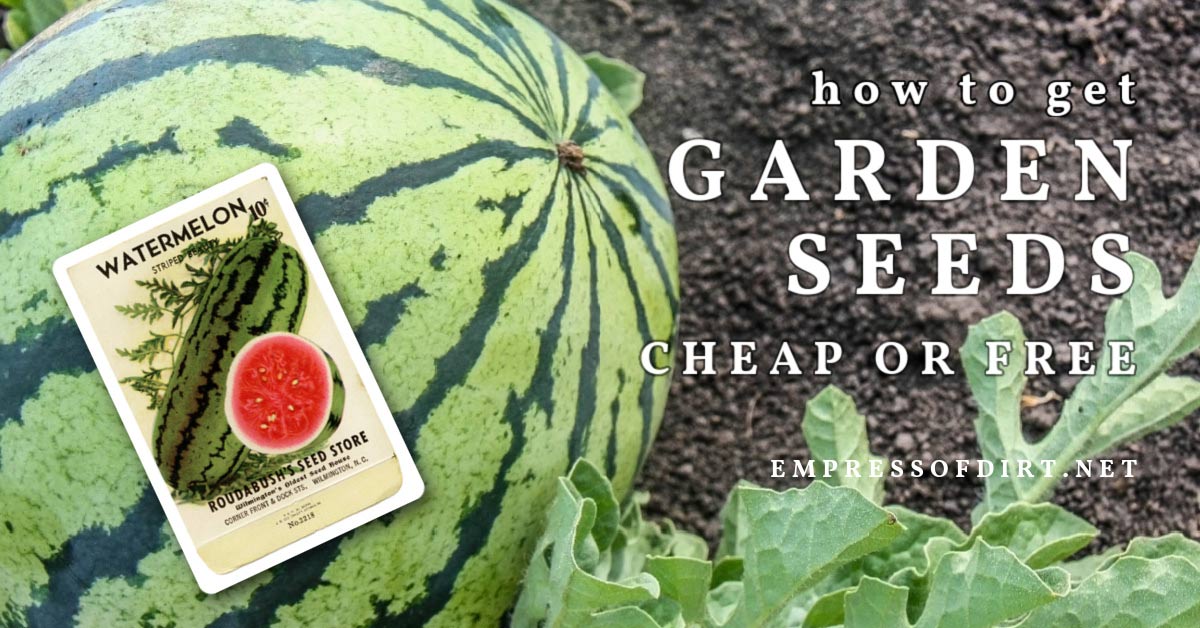10 Easy Ways to Cut Costs on Garden Seeds
If you want to cut costs with seeds for your garden, there are plenty of resources both locally and online where you can get seeds either free or at a discount.
I’ve always been a thrifty gardener and enjoy saving money where I can. This article on 7 Cheap (But Smart) Tips to Create Your Dream Garden goes into more detail on how I got started creating a garden from scratch on a very low budget.

Free & Low-Cost Seed Sources

While a pack of garden seeds may cost just a few bucks, it can really add up if we want to grow a variety of plants. Suddenly those handfuls of seed packets are digging into our garden budgets.
A lot of readers ask about money-saving ideas so I thought it would be fun to create a list of every way I know to lower seed costs.
This isn’t a diss against seed companies—when you know what goes into it, the cost of seeds is not outrageous—and I don’t think we should put the burden on them.
But we can still network and make use of community resources (both physical and virtual) to make things work better for us.
I’ll be the first to admit that some of the ideas might sound good on paper but be hard to pull off—but some should definitely help.
Check Locally


Seed Libraries: Many libraries or community centers offer seed “borrowing” programs. Each have their own rules but generally you get access to some quantity of free seeds with the opportunity to give back.
Community Swaps: Share and swap surplus seeds with friends or join a local garden club or horticultural society. If they don’t already have seed exchanges, you can always suggest the idea and volunteer to help.
Watch for Seedy Saturdays or other in-person seed exchanges. These often take place in spring during pre-season garden events.
Shop Your Own Garden: Learn to save seeds from your own plants. This way, you get free seeds with spare to share. This has more tips on saving seeds from your garden.
Online
There are some restrictions on shipping seeds across borders so check what’s permitted if you’re looking outside your own country.
Virtual Seed Swaps: There are numerous online communities on sites like Facebook that have gardeners eager to share or swap seeds. But, just as in “real” life, there’s also no shortage of scammers, so do be cautious.
Support Seed Saving Initiatives: Organizations like Seed Savers Exchange and Seeds of Diversity champion biodiversity and promote responsible seed collection practices.
- Seed Savers Exchange (United States) | “We’re a community of gardeners and seed stewards, sharing and swapping rare seeds you might not find anywhere else. The Exchange works to keep biodiversity strong and garden traditions thriving.”
- Seeds of Diversity (Canada) | “We are a group of seed savers from coast to coast who protect Canada’s seed biodiversity by growing it ourselves and sharing it with others.”
More Money-Saving Strategies
Plan Ahead: Buying seeds out of passion instead of planning leads to surplus seeds that never get sown. Come up with a realistic plan for the growing season ahead based your actual garden space and the time you have available to tend it. This should help cut down on over-shopping. Maybe.
If you are sowing perennials in addition to annual vegetables and flowers, learn about native plants that benefit your region versus invasive species that can cause long-lasting damage.
Find Sales & Coupons: Many online seed shops offer initial discounts for signing up for their newsletters and have sales throughout the year. It’s also worth googling the name of the seed company + coupon to find other offers.
Bulk Up (Strategically): Partner with fellow gardeners for bulk orders to split costs and potentially reduce shipping fees. Ship to one location and have a seed packing party to divide up the haul.
Read Seed Packets: Know what you’re getting, paying specific attention to seed counts or weights listed on packets. Some seed packets contain hundreds or even thousands of seeds while others may have just a few. This, combined with expected germination rates, lets you know what to reasonably expect. It’s also important to know the age of seeds and how long they retain good germination rates. I mark my seed packets so the oldest ones are sown first each year.
Sow Sparingly: Some gardeners like to broadcast seeds while others like me prefer to sow seeds individually. It’s a bit fussy in the moment but, with no seedlings to thin out, it really saves money in the long run.
Store Seeds Properly: keep your seeds well organized and stored properly (cool, dry, dark) so they last as long as possible and get used in good time.
More Seed Tips
Resources
Ebook


Seed Starting for Beginners
Sow Inside Grow Outside
by Melissa J. Will
NEW EDITION | Everything you need to get started with indoor seed starting for indoor and outdoor plants. Grow what you want—any time of year!
About This Ebook | Visit Ebook Shop
This ebook is a digital file (PDF format) you save to your device. It is not a physical product.
PayPal, Credit Card, Apple Pay
Available for Canada & United States only.
~Melissa the Empress of Dirt ♛






